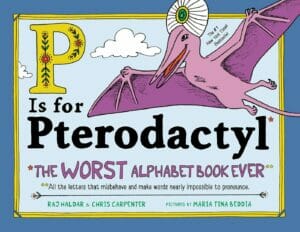Fun with Words: Wordplay in Children’s Picture Books
by Hannah Atchison, Children’s Librarian

The first step to developing a love of reading is to develop a love of words. To nurture a love of words, you need to create positive memories and associations. Reading picture books that use wordplay with your child is one of the best ways to associate comfort and love with a good book. Encourage your child to play with words and sounds the way they play with other things.
Here are a few of my favorite picture books that use wordplay.
“Amelia Bedelia” by Herman and Peggy Parish. I grew up reading these. They made me laugh and laugh. The originals are actually in our beginning readers collection, but we have some in our picture books and chapter books too. In the picture books Amelia is only a child, but in the beginning readers, Amelia Bedelia works as a housekeeper. The books are about her confusion with odd phrases. Instructed to dress the turkey, she sews him clothes. The kids will learn what these phrases mean and enjoy all of Amelia’s hilarious mistakes.
“The Book with No Pictures” by B. J. Novak. This book has no pictures, but will keep your kid engaged. It is filled with funny words and sounds that the grown-up who is reading has to say.
“Chicka Chicka Boom Boom” by Bill Martin. I read this one when I was little and I use it frequently in my storytimes. The lowercase alphabet is climbing up a coconut tree. But the tree gets crowded and they all fall out. This book uses rhyming and rhythm to teach the kids their letters. Reading a book with rhythm and tapping your legs or clapping your hands is also a great way for the kids to learn about and practice syllables.
“The Great Dictionary Caper” by Judy Sierra. This is a playful book about the different kinds of word groups that ‘hang out’ and what they do together. The action verbs are very active and the interjections are always interrupting. When the words have a parade, everyone shows off.
“Llamaphones” by Janik Coat. This is a book about homophones, words that sound the same, but mean different things, that uses llamas to illustrate them. This book is part of a collection that also includes, “Comparrotives” and “Hippopposites”. The library has all of these in board book format so that even the smallest humans may enjoy them.
“Moose, Goose, and Mouse” by Mordicai Gerstein. Moose, Goose, and Mouse need a house. This book plays with rhymes and word sounds.
“P is for Pterodactyl: The Worst Alphabet Book Ever: All the Letters that Misbehave and Make Words Nearly Impossible to Pronounce” by Raj Haldar. This book has been one of my favorites for a few years now. It has a sequel which is equally enjoyable. “No Reading Allowed: The Worst Read-Aloud Book Ever: A Confusing Collection of Hilarious Homonyms and Sound-Alike Sentences.” These books are a great way to laugh some of the more frustrating elements of language.
“7 Ate 9: The Untold Story” by Tara Lazar. Private I is solving a missing person, or number, case. Number 9 is missing and rumor is, 7 ate 9. This book plays with both numbers and words.
“Where’s the Baboon?” by Michael Escoffier. Using different colored font, this book hides the answers to questions in other words. This is a good introduction to anagrams, new words you create by mixing up letters, and compound words.
“The Whole Hole Story” by Vivian McInerny. This is another new favorite of mine. If you enjoy stream of consciousness and a good bit of nonsense, give this book a try.
“Wordplay” by Ivan Brunetti. This book is actually a beginning reader in our collection included in the Toon Books series. Several examples of compound words are given with silly illustrations and stories to go with them.
Wordplay is both silly and informative. Reading picture books that use wordplay with your child will allow them to explore how language works in a fun and meaningful way. Find a book that you both will enjoy. It doesn’t have to be from this list. It could be another one from the library collection, or one you have at home. Learning doesn’t have to be serious. Thank goodness.

